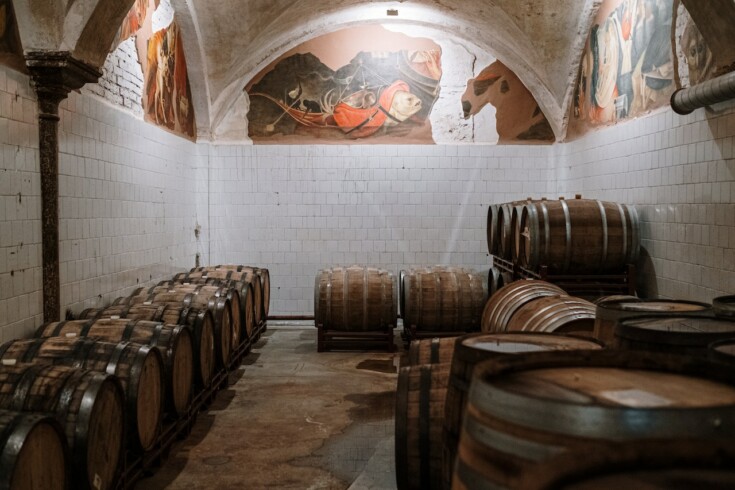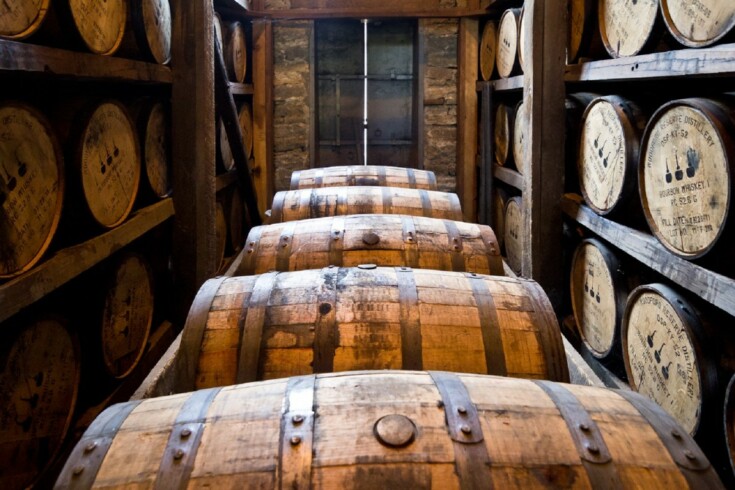
Whiskey barrels are an essential component of the whiskey-making process. They are used to store and age the whiskey, which gives it its distinct flavor and aroma. But have you ever wondered how much whiskey is in a barrel? The answer is not as straightforward as you might think. Understanding how much whiskey is in a barrel and how many bottles can be produced is important for both producers and consumers alike.
Table of Contents
Whiskey Barrel Basics
Whiskey barrels are an essential part of the whiskey-making process. They are used to store and age whiskey, and they play a significant role in the final flavor and quality of the product. Here are some basic things you should know about whiskey barrels:
Barrel Sizes
Whiskey barrels come in different sizes, but the most commonly used sizes in the industry are the 53-gallon (200-liter), 30-gallon (114-liter), and 15-gallon (57-liter) barrels. These standard whiskey barrel sizes have been used for centuries and are an integral part of the aging and flavor development process.
Barrel Types
There are two main types of whiskey barrels: American oak and European oak. American oak barrels are the most commonly used type of barrel in the whiskey industry. They are made from white oak and have a high level of natural sweetness and vanilla flavor. European oak barrels, on the other hand, are made from oak species like Quercus robur or Quercus petraea and are known for their spicy and tannic flavors.
Barrel Reuse
Whiskey barrels are often reused to age different types of whiskey. For example, a barrel that was previously used to age bourbon can be used to age scotch or Irish whiskey. This process is called “finishing,” and it can add unique flavors and characteristics to the whiskey.
Barrel Proof
Barrel proof whiskey is whiskey that has not been diluted with water before bottling. The proof of the whiskey is the percentage of alcohol by volume (ABV). Barrel proof whiskey is typically bottled at a higher proof than regular whiskey, which can range from 80 to 100 proof. Barrel proof whiskey is often preferred by whiskey connoisseurs because it has a more robust flavor and aroma.
 photo credit: pxhere.com
photo credit: pxhere.com
Barrel Size and Whiskey Quantity
The size of a whiskey barrel can vary, but the standard American barrel holds between 50 and 53 gallons (190-200 liters) of whiskey. This size is most often used when whiskey is matured. In Scotland, coopers often use bourbon barrels to mature Scotch whiskey.
Smaller barrels are also used for whiskey aging. For example, a quarter barrel, also known as a 15-gallon barrel, has dimensions of 18 inches in height and 14 inches in diameter, with a capacity of 15 gallons. This size is typically used for small-batch and high-end products, as well as for experimental whiskey aging.
Larger barrels, such as 59-gallon barrels, are also used for aging whiskey commercially. They hold more volume and can mature bourbon efficiently over years.
The following table summarizes the most common barrel sizes used for whiskey aging:
| Barrel Size | Capacity (Gallons) | Capacity (Liters) |
| Quarter | 15 | 57 |
| Half | 25-30 | 95-114 |
| Standard | 50-53 | 190-200 |
| Barrel | 59 | 223 |
It is important to note that the size of the barrel can affect the flavor of the whiskey. Smaller barrels tend to age whiskey faster and impart more intense flavors, while larger barrels age whiskey more slowly and impart milder flavors.
Factors Affecting Whiskey Volume
Several factors can affect the amount of whiskey that can be produced from a barrel. Here are some of the most important factors:
Barrel Size and Capacity
The size and capacity of the barrel are the most significant factors that can affect the amount of whiskey produced. The standard whiskey barrel has a capacity of 53 gallons, according to industry norms. However, there are different barrel sizes, and the amount of whiskey produced will vary depending on the size of the barrel.
Here are some of the most common barrel sizes and their respective capacities:
- Butt: 475-500 liters
- Puncheon: 450-500 liters
- Barrique: 250-300 liters
- Hogshead: 225-250 liters
- American Standard Barrel: 190-200 liters
Type of Whiskey
Different types of whiskey require different aging processes, which can affect the amount of whiskey produced. For example, bourbon whiskey must be aged in new, charred oak barrels, while Scotch whiskey is often aged in used bourbon barrels. The type of whiskey and the aging process can affect the amount of whiskey produced.
Climate
The climate can also affect the amount of whiskey produced. In warmer climates, the whiskey can evaporate more quickly, leading to a higher rate of evaporation and a lower yield. Conversely, in cooler climates, the whiskey can age more slowly, leading to a lower rate of evaporation and a higher yield.
Angel’s Share
The angel’s share is the amount of whiskey that evaporates during the aging process. The amount of angel’s share can vary depending on the climate, the type of whiskey, and the aging process. However, on average, the angel’s share is around 2% per year. This means that a barrel of whiskey aged for 10 years can lose up to 20% of its volume due to evaporation.
Storage Conditions
Finally, the storage conditions can also affect the amount of whiskey produced. The temperature, humidity, and light exposure can all affect the aging process and the amount of whiskey produced. For example, if the barrel is stored in a humid environment, the whiskey can absorb more water, leading to a lower yield. Similarly, if the barrel is exposed to too much light, the whiskey can oxidize, leading to a lower quality and a lower yield.
How Much Whiskey is in a Barrel?
In terms of how much whiskey is in a barrel, the answer can vary depending on the size of the barrel and the type of whiskey being produced. In general, an American standard barrel will hold between 50 and 53 gallons of whiskey, while a quarter cask can hold around 50 liters. This means that a barrel of whiskey can contain anywhere from around 200 to 266 750 ml bottles of whiskey, depending on the size of the barrel and the amount lost to evaporation.
Standard Measurements in Whiskey Production
When it comes to whiskey production, there are standard measurements that are used in the industry. One of the most important measurements is the size of the barrel in which the whiskey is aged. The standard barrel size used in bourbon production is the 53-gallon oak barrel. However, distillers also use smaller barrel sizes, including the 30-gallon and 15-gallon barrels.
The American standard barrel is most often used when whiskey is matured. It holds between 50 and 53 gallons (190-200 liters) of whiskey. In Scotland, coopers often use bourbon barrels to mature Scotch whiskey.
The size of the barrel can affect the taste and quality of the whiskey. A smaller barrel can result in a more intense flavor, as the whiskey has more contact with the wood. However, it also means that the whiskey can mature more quickly, which can result in a less complex flavor.
Aside from barrel size, there are other measurements that are important in whiskey production. One of these is the alcohol by volume (ABV) percentage. The ABV is the percentage of alcohol in the whiskey. In the United States, whiskey must have an ABV of at least 40% to be considered a whiskey.
Another important measurement is the age of the whiskey. The age of the whiskey is the amount of time it has spent in the barrel. The longer the whiskey has aged, the more complex its flavor will be. However, this also means that the whiskey will be more expensive, as it has been aged for a longer period of time.
Frequently Asked Questions
What is the standard size of a whiskey barrel?
The standard size of a whiskey barrel is 53 gallons, which is equivalent to 200 liters. This size is commonly used in the United States for aging whiskey.
How many bottles of whiskey can be produced from a single barrel?
The number of bottles that can be produced from a single barrel varies depending on the size of the bottles and the amount of evaporation that occurs during the aging process. In general, most standard-sized whiskey barrels will yield between 180-250 bottles. However, it’s important to note that individual distilleries may have their own unique filling practices which could affect the final bottle count.
What is the typical age of whiskey stored in a barrel?
The typical age of whiskey stored in a barrel varies depending on the desired flavor profile and the type of whiskey being produced. Bourbon, for example, must be aged for a minimum of two years to be considered “straight bourbon.” Scotch whiskey, on the other hand, must be aged for a minimum of three years.
How does the size of the barrel affect the flavor of the whiskey?
The size of the barrel can have a significant impact on the flavor of the whiskey. Smaller barrels tend to age whiskey more quickly and impart more intense flavors, while larger barrels age whiskey more slowly and produce a smoother, more mellow flavor profile.
What is the difference between a new and used whiskey barrel?
New whiskey barrels are typically made from American white oak and are used for the first time to age whiskey. Used whiskey barrels, on the other hand, have already been used to age whiskey and are often sold to other distilleries or used for other purposes, such as aging wine or beer. Used barrels can also impart different flavors to the whiskey depending on what was previously aged in them.
How much does a barrel of whiskey cost?
The cost of a barrel of whiskey can vary widely depending on a number of factors, including the type of whiskey being produced, the size of the barrel, and the quality of the wood used to make the barrel. In general, a new 53-gallon barrel can cost anywhere from $250 to $500, while a used barrel can cost anywhere from $50 to $200.
Conclusion
The amount of whiskey in a barrel varies depending on the type of barrel used. The American standard barrel, which is the most commonly used barrel for whiskey maturation, holds between 50 and 53 gallons (190-200 liters) of whiskey. Meanwhile, the typical measurement for standard barrels is 53 gallons, also known as American Standard Barrel (ASB).
Based on these measurements, a full barrel of whiskey can yield approximately 265 to 267 750-milliliter bottles of whiskey. However, it is important to note that the number of bottles may vary depending on factors such as evaporation, barrel size, and the type of whiskey being produced.
It is also worth noting that the cost of a full barrel of whiskey can vary widely depending on factors such as the age and quality of the whiskey, the type of barrel used, and the location of the distillery. According to some sources, a 60-gallon French oak barrel of wine costs approximately $900 each.
Understanding the amount of whiskey in a barrel is important for distillers, as it can help them determine the quantity and quality of whiskey they can produce. While there are some variations in barrel size and yield, the standard measurements for whiskey barrels provide a useful guide for those in the industry.
Related Posts
Here are some related posts about the whiskey industry and enjoying a good dram:
- How would a “Brexit” impact the UK Whisky Industry?: This post discusses the potential impact of Brexit on the UK whisky industry, which is Britain’s largest food and drink export.
- Where to enjoy a good dram in Toulouse (FR)?: The author shares their personal selection of whisky-friendly bars in Toulouse, France, where whisky isn’t the most popular drink.
- Where to enjoy a good dram in Stockholm?: This post highlights the Ardbeg Embassy, a bar in Stockholm with a unique atmosphere and a small but impressive whisky selection.
- Where to enjoy a good dram in Bangkok? Part 1/2: The author takes readers on a tour of Bangkok’s whisky hotspots, including the popular Whisgars.
- Where to enjoy a good dram in Bangkok? Part 2/2: This post continues the tour of Bangkok’s whisky bars, featuring the stylish and sophisticated Hyde & Seek Gastro Bar.



